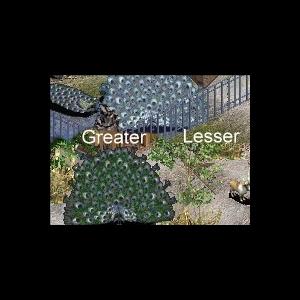About This File
Greater Slate-backed Peafowl
Found in the Himalayas. The grayish color of its feathers allow it to blend into its rocky habitat.
Slate-backed have shorter tails and have better flight ability than other peafowl. This allows them to fly from niche to niche, where they often make their roosts and nests. The bulky tails of the India Blue would easily be caught by the high winds, ripping the birds from their perches.
Slate-backed males lose their long tail feathers in late summer and regrown them in early spring. In spring, their mating calls can be heard throughout the mountains. During their short-tailed seasons, it's often hard to tell males and females apart.
Slate-backs usually pair off rather than have harems, mating for life. Depending on the male, he will either take turns brooding the eggs or bring food to his mate (and later chicks). Hens usually lay one or two eggs, under an overhang that can only be reached by flight.
Greater Slate-backs prefer the coniferous forests over the rocky cliffs that the lesser prefer, however, they are equally comfortable in the lesser slate-backs' habitat. The green lazing their trail allows for better blending in.
They make a diet of the pine seeds, berries, and fungi found on the forest floor.
NOTE: 100% compatible with both the Markhor and the Lesser Slate-backed Peafowl
Lesser Slate-backed Peafowl
Found in the Himalayas. The grayish color of its feathers allow it to blend into its rocky habitat.
Slate-backed have shorter tails and have better flight ability than other peafowl. This allows them to fly from niche to niche, where they often make their roosts and nests. The bulky tails of the India Blue would easily be caught by the high winds, ripping the birds from their perches.
Slate-backed males lose their long tail feathers in late summer and regrown them in early spring. In spring, their mating calls can be heard throughout the mountains. During their short-tailed seasons, it's often hard to tell males and females apart.
Slate-backs usually pair off rather than have harems, mating for life. Depending on the male, he will either take turns brooding the eggs or bring food to his mate (and later chicks). Hens usually lay one or two eggs, under an overhang that can only be reached by flight.
A subspecies of the Greater Slate-back, Lesser Slate-backs prefer the the rocky cliffs. Their trail lacks the vibrant green of the Greater, and the coloring has less contrast than what most peafowl are known for. This allows for blending in with the gray rock.
Lesser depend more on insects and lichen than their forest-dwelling brethern.
NOTE: 100% compatible with both the Markhor and the Greater Slate-backed Peafowl
Updated 2010-11-21
Just to save space with less in zip and smaller image.
Nothing new.



Recommended Comments
There are no comments to display.
Create an account or sign in to comment
You need to be a member in order to leave a comment
Create an account
Sign up for a new account in our community. It's easy!
Register a new accountSign in
Already have an account? Sign in here.
Sign In Now